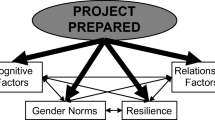Abstract
An exploratory study was conducted to determine if: (1) web-linked computer interventions can help low-income minority teens maintain or increase condom use; (2) directed use of computers for health purposes during clinic waiting room time is more helpful than is self-generated computer use. Teen clinics were randomly assigned to treatment and comparison conditions. Teens attending treatment clinics were directed to view one of two very brief condom-promoting PowerPoint presentations linked to teen-friendly health websites. Teens attending comparison clinics were allowed to use the computers for whatever purposes they chose. Treatment teens returning for follow-up appointments 3–6 months later knew more of the relevant information and were more likely to have “always” used condoms than comparison teens who did not have directed guidance in using the computers. This study suggests that to achieve meaningful outcome-based health education using computers and the Internet in clinics serving low-income minority youth, directed learning is likely to be more efficacious than unguided exploration or general use. Indeed, directed learning using technology may help reduce some of the health disparities experienced by low-income minority youth by increasing protective behaviors. Further research on this approach is merited.
Similar content being viewed by others
References
Borzekowski, D. L., & Rickert, V. I. (2001). Adolescents, the internet, and health: issues of access and content. Journal of Applied Developmental Psychology, 22, 49–59.
Borzekowski, D. L., Fobil, J. N., & Asante, K. O. (2006). Online access by adolescents in Accra: Ghanaian teens’ use of the internet for health information. Departmental Psychology, 43(3), 450–458.
Braun-Courville, D. K., & Rojas, M. (2009). Exposure to sexually explicit web sites and adolescent sexual attitudes and behaviors. Journal of Adolescent Health, 45(2), 156–162.
Clark, L. R., Jackson, M., & Allen-Taylor, L. (2002). Adolescent knowledge about sexually transmitted diseases. Sexually Transmitted Diseases, 29(8), 436–443.
DiClemente, R. J., Boyer, C., & Morales, E. S. (1998). Minorities and aids: knowledge, attitudes, and misconceptions among Black and Latino adolescents. American Journal of Public Health, 78(1), 55–57.
Gray, N. J., Klein, J. D., Noyce, P. R., Sesselberg, T. S., & Cantrill, J. A. (2005). Health information-seeking behavior in adolescence: the place of the internet. Social Science & Medicine, 60(7), 1467–1478.
Hansen, D. L., Derry, H. A., Resnick, P. J., & Richardson, C. R. (2003). Adolescents searching for health information on the internet: an observational study. Journal of Medical Internet Research, 5(4), e25.
Howard, M., & Davis, J. A. (2004). Community technology centers, a focus on teens and their parents in health care sites: final report, Grant Award #V341A990192 US Department of Education.
Howard, M., Levine, Davis, J. A., & Peek, M. (2003). Overcoming online health education disparity. Journal of Multicultural Nursing and Health, 9(3).
Issacson, N. (2006). An overview of the role of sexual health organizations, corporations, and government in determining content and access to online sexuality education for adolescents. Sexuality Research and Social Policy: Journal of National Sexuality Research Center, 3(2), 29–30.
Keller, S., LaBelle, H., Karimi, N., & Gupta, S. (2002). STD/HIV prevention for teenagers: a look at the internet universe. Journal of Health Communication, 7, 341–353.
Lenhart, A., Madden, M., & Hitlin, P. (2005) Teens and technology: youth are leading the transition to a fully wired and mobile nation. Pew Internet & American Life Project.
Rideout, V. (2001). Generation RX.com: How young people use the internet for health information, Kaiser Family Foundation pg 2.
Skinner, H., Biscope, S., Poland, B., & Goldberg, E. (2003). How adolescents use technology for health information: implication for health professionals from focus group studies. Journal of Medical Internet Research, 5(4), e32.
Vargas, K. (2005). Teenagers, health, and the internet: how information professionals can reach out to teens and their health information needs. Journal of Consumer Health on the Internet, 9(3), 15–23.
Warschauer, M., & Matuchniak, T. (2010). New technology and digital worlds: analyzing evidence of equity in access, use, and outcomes. Review of Research in Education, 34, 179.
Zeng, Q. T., Kogan, S., Povnick, R. M., Crowell, J., Lacroix, E. M., & Greenes, R. A. (2004). Positive attitudes and failed queries: an exploration of the conundrums of health information retrieval. International Journal of Medical Informatics, 73(1), 45–55.
Acknowledgment
This article is based on a presentation, Reducing Teen Health Disparities through Technology, given at the University of Chicago-sponsored One-Day Symposium on “Virtual Sex Ed: Youth, Race, Sex and New Media”, June 5, 2009, Chicago, Illinois. We thank Grady Health System Teen Services Program for their assistance with this project along with Melissa J. Kottke MD, MPH who reviewed project materials for medical accuracy. Daniel S. Blumenthal, MD, MPH provided helpful comments on a draft of this paper. This research was supported by funds granted by the Brush Foundation to the Morehouse School of Medicine Prevention Research Center. It was also supported by grant 5U48DP000049 from the Centers for Disease Control and Prevention to Morehouse School of Medicine and a grant from the Kendeda Fund to Emory University School of Medicine Jane Fonda Center, Atlanta, GA, USA.
Author information
Authors and Affiliations
Corresponding author
Rights and permissions
About this article
Cite this article
Howard, M.N., Davis, J.A. & Mitchell, M.E. Improving Low-Income Teen Health Behaviors with Internet-Linked Clinic Interventions. Sex Res Soc Policy 8, 50–57 (2011). https://doi.org/10.1007/s13178-011-0037-2
Published:
Issue Date:
DOI: https://doi.org/10.1007/s13178-011-0037-2




